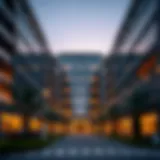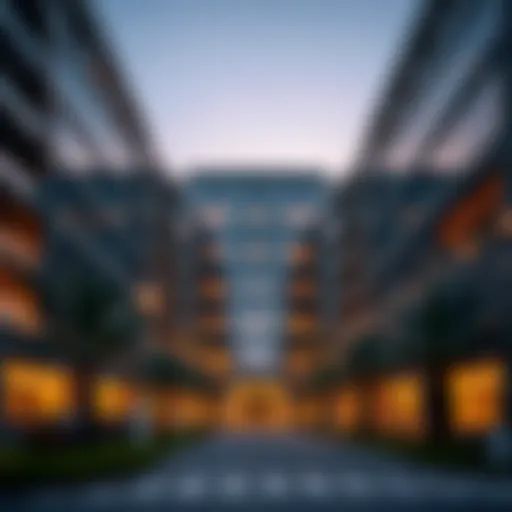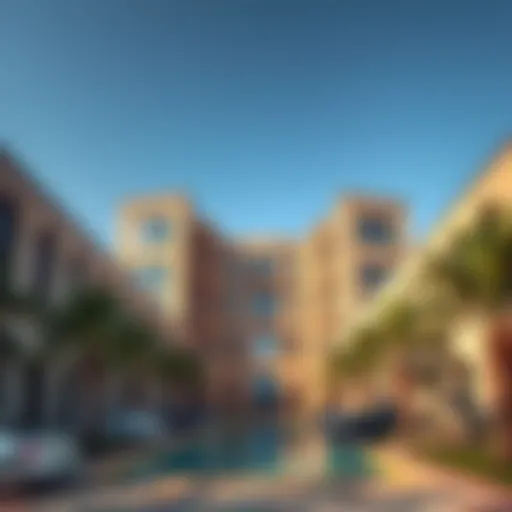Exploring the Juma Al Majid Building in Al Nahda
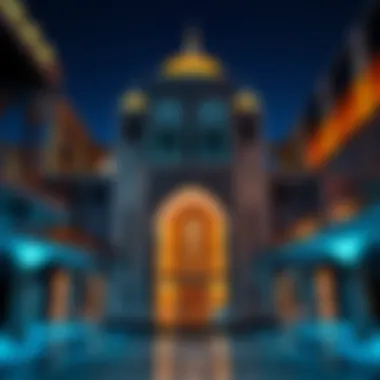

Intro
The Juma Al Majid Building, proudly anchored in the heart of Al Nahda, serves as both a historical monument and a modern architectural standout. It is a tangible representation of the past meshed with the present, offering a glimpse into Dubai's rapid transformation over the decades. With its striking façade and thoughtful design, this building is not just a structure; it symbolizes a thriving community and a growing interest in the area.
As we venture further into the myriad features that characterize the Juma Al Majid Building, it becomes clear that its significance extends beyond mere aesthetics. Investors, homeowners, and real estate enthusiasts alike should appreciate how this establishment plays an integral role in shaping the local market dynamics and community culture. From architectural brilliance to lucrative investment opportunities, it is worth dissecting the layers that make this building a focal point of interest.
Market Trends
Current Real Estate Landscape
The Al Nahda district has undergone significant changes over the years, turning into a bustling hub for both residential and commercial properties. The Juma Al Majid Building stands at the crossroads of this evolution, illustrating how the area has attracted diverse demographics, from young professionals to established families. Properties in this region enjoy a competitive edge, primarily due to their proximity to essential amenities such as schools, shopping centers, and health facilities.
Moreover, the neighborhood's access to public transport adds to its appeal, making it convenient for residents and businesses alike. Modern conveniences combined with cultural facets keep the demand for real estate steady, assuring investors of ongoing interest in the area.
Property Price Trends
In recent months, property prices in Al Nahda have witnessed noteworthy fluctuations, with average rental costs experiencing a gradual climb. Recent studies indicate that rental rates have increased by approximately 7% compared to last year. This growth reflects a broader trend in Dubai's real estate sphere, with many investors viewing Al Nahda as a sanctuary for high returns.
- Average Property Prices:
- One-bedroom apartments: AED 850,000
- Two-bedroom apartments: AED 1,300,000
The continuous rise in population also fuels the demand for housing, prompting developments in new apartment complexes and commercial spaces. Assuredly, the Juma Al Majid Building benefits from this trend as it offers a blend of retail and office units targeted at emerging businesses.
"The importance of the Juma Al Majid Building cannot be overstated; it embodies the fusion of history and progression within a thriving marketplace."
Investment Opportunities
High-Return Areas
In light of the growing real estate sector, certain zones surrounding the Juma Al Majid Building have become hotspots for prospective investors. Areas boasting urban development, coupled with cultural touchstones, elevate the investor interest. Some key areas to observe include:
- Al Nahda First: Known for its residential units that attract diverse renters.
- Al Qusais: This nearby zone is excellent for those interested in the commercial domain, with a variety of offices and storefronts.
Upcoming Developments
The future of the Al Nahda real estate market looks promising alongside the developments slated for construction. Projects focusing on sustainability and modern living designs are in the pipeline, ensuring that the community continues to evolve into an attractive destination for both homeowners and business owners. Noteworthy upcoming developments include:
- The Al Nahda Grand Mall: A vast shopping center poised to become a landmark.
- New residential towers: Aimed at middle-income families looking for affordable housing.
In summary, the Juma Al Majid Building not only represents a significant architectural feat but also stands as a testament to the vibrant market dynamics brewing within Dubai's Al Nahda. Investors keen on maximizing returns will find ample opportunities, while casual observers can appreciate the cultural resonance that this building encapsulates.
Intro to the Juma Al Majid Building
The Juma Al Majid Building is more than just a striking edifice in the heart of Dubai's Al Nahda district; it serves as a beacon of the intersection between history and innovation. Visitors and residents alike find themselves drawn to this establishment, not only for its contemporary facilities but also for the deeply rooted cultural narratives it encapsulates. In a landscape that continuously changes, the building manages to maintain a sense of heritage while fostering modern commercial activities. This article endeavors to traverse the various layers of significance that the Juma Al Majid Building offers, presenting a comprehensive guide for diverse audiences ranging from potential investors to casual observers.
Historical Context
Understanding the historical background of the Juma Al Majid Building adds depth to its existence. Constructed during a pivotal period of Dubai's modernization, it reflects the broader trends of economic and social transformation in the region. Dubai, once a modest trading port, has burgeoned into a global business hub, and this building stands as a testament to that evolution. The architect behind this structure drew inspiration from traditional Islamic motifs, embedding a sense of time-honored craftsmanship into the modern framework. For those interested, historical insights into the building's inception can be explored further at Wikipedia.
Architectural Significance
The architecture of the Juma Al Majid Building is riveting in its ability to marry beauty with function. Boasting a modern style, it incorporates traditional elements that resonate with the rich cultural fabric of the UAE. Key architectural features include:
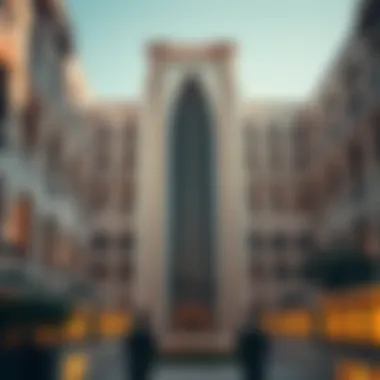

- Intricate facades: The external design employs a mix of glass and local stone, striking a balance between transparency and solidity.
- Open spaces: The interiors are designed to facilitate community interaction, promoting a vibrant atmosphere for both business and leisure activities.
- Technological integration: Smart building technologies not only enhance the user experience but also promote sustainability—an increasingly vital consideration in today’s architectural landscape.
The building's design has garnered attention for its pioneering approach to architectural solutions catered to Dubai's unique climate and urban demands. With elements that capture sunlight efficaciously while keeping insides cool, it thus exemplifies the marriage of aesthetics and utility.
The Juma Al Majid Building isn't merely a structure; it symbolizes the synergy of tradition and progress, fostering a sense of unity in diversity.
In summary, exploring both the historical context and the architectural significance of this building provides a complete perspective on why it is a pivotal part of the Al Nahda district’s identity.
Location and Accessibility
The significance of location and accessibility cannot be overstated when discussing the Juma Al Majid Building. In the dynamic environment of Dubai and especially within the Al Nahda area, the ease with which residents and visitors can access this landmark greatly enhances its stature. The layout and placement of this building play a pivotal role in shaping its utility and value. As demand for prime spaces grows, understanding the geographical and transportational advantages can give insights into its commercial promise.
Geographical Advantages of Al Nahda
Al Nahda, a vibrant suburb located near the borders of Dubai and Sharjah, presents unique geographical advantages that contribute to the prominence of the Juma Al Majid Building. This area blends residential comfort with industrial vigor, attracting diverse demographics.
- Proximity to key areas: Al Nahda is located just a stone's throw away from Dubai’s bustling center and Sharjah, making it notable for business and leisure. The ease of reaching major districts is a significant pull factor for both businesses and families.
- Natural Environment: Al Nahda benefits from parks and green spaces, which provide not only aesthetic beauty but high livability standards. This enhances the site's desirability, fostering community engagement and healthy lifestyle choices.
- Radiant Development: With continuous urban expansion and development, Al Nahda is experiencing a surge in construction. This brings opportunities for commercial spaces and residential projects, of which the Juma Al Majid Building stands as a central figure.
The area's demographic mix, facilitating a vibrant community, ultimately adds to the commercial viability of any establishments located there.
Transportation Links
Accessibility is further amplified by the robust transportation framework surrounding the Juma Al Majid Building. Effective connectivity through various modalities caters to the needs of commuters and boosts the building's appeal.
- Road Connectivity: The area is crisscrossed by major roads and highways such as the Emirates Road and Al Ittihad Road, allowing smooth transit between Dubai’s commercial sectors and neighboring emirates.
- Public Transport Options: With the public bus services operating frequently and metro stations located within a reasonable distance, residents and businesses enjoy the ease of commutes. Notably, the Al Nahda Metro Station facilitates direct access to key locations within Dubai.
- Future Developments in Transport: Plans for expanding transportation networks, including dedicated bus lanest and possibly future metro extensions, are in the pipeline. Such improvements would likely further increase the Juma Al Majid Building's foot traffic.
"The strategic location coupled with robust transport links makes Al Nahda not just a living space, but a thriving hub for commerce and community life."
In sum, the Juma Al Majid Building is bolstered by both its geographical benefits and state-of-the-art transport options, making it an essential point of interest in discussions about Dubai's real estate dynamics. Understanding these layers of accessibility not only demonstrates the building's potential but opens the door to prospective opportunities for investment and development.
Design and Architecture
The Juma Al Majid Building in Al Nahda isn't just a structure; it's a grand narrative woven with threads of history, culture, and modernity. Understanding its design and architecture is essential, not only for appreciating its visual aesthetics but also for recognizing its role in the fabric of Dubai’s urban environment. The building's architectural choices speak volumes about the region's evolving identity while addressing practical considerations like functionality and sustainability.
Architectural Style
The architectural style of the Juma Al Majid Building reflects a harmonious blend of traditional Islamic elements and modern design philosophies. The facade prominently features intricate geometric patterns and arabesque motifs, reminiscent of the rich heritage that permeates much of the Middle East. Contributing to its grand visual appeal are large, arched entrances and soaring ceilings designed to evoke a sense of openness and inclusion.
Visitors and locals alike are greeted by these distinct yet inviting characteristics. The thoughtful interplay between light and shadow, achieved through strategically placed windows, enhances the aesthetic experience while maintaining a connection to the surroundings. The simple elegance of the design serves not only to elevate the overall ambiance but also to respect the cultural roots that have shaped the region.
Materials Used
When examining the materials used in constructing the Juma Al Majid Building, it’s clear that they were selected with intention. The use of high-quality steel and reinforced concrete provides structural integrity and durability, key for a building that's part of a bustling urban environment.
To highlight its unique architectural style, the building incorporates local materials like sandstone, which not only enhances its visual appeal but also reflects traditional building practices in the region. The integration of glass elements adds a contemporary touch, allowing natural light to filter through while framing views of the surrounding skyline.
Moreover, the selection of materials aligns with the sustainability initiatives discussed later, such as energy efficiency and low maintenance. The building’s foundation rests on these choices, representing a seamless fusion of aesthetic ambition and practical necessity.
Sustainability Features
Sustainability is more than a buzzword for the Juma Al Majid Building; it’s embedded in its design ethos. The building showcases various sustainability features that aim to minimize its environmental footprint while providing a healthy space for occupants.
One of the notable aspects is the implementation of energy-efficient systems. The building is equipped with advanced HVAC systems that optimize energy use while ensuring occupant comfort. Additionally, rainwater harvesting systems are integrated to conserve resources, reflecting a commitment to responsible resource management.
Natural ventilation is also prioritized, pulling in fresh air while reducing reliance on mechanical systems. The lush landscaping surrounding the building is not merely decorative; it plays a critical role in improving the microclimate and promoting biodiversity in an urban setting.
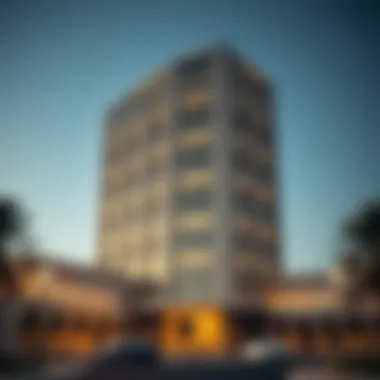

A clear commitment to sustainable practices positions the Juma Al Majid Building not just as an architectural gem but as a forward-thinking model for future developments in Al Nahda and beyond. In summary, the design and architecture of the Juma Al Majid Building exemplify a thoughtful approach to creating spaces that harmonize with both cultural significance and modern sustainable practices.
Commercial Potential
The commercial potential of the Juma Al Majid Building is a cornerstone of its appeal within Dubai's fast-paced economic environment. As Al Nahda continues to evolve into a key business hub, this building stands poised to attract both local and international investments. Businesses looking to establish a presence in a thriving area will find this location particularly advantageous. The blend of modern amenities and a vibrant community offers an attractive proposition for companies seeking growth opportunities.
Business Opportunities
The Juma Al Majid Building is well-positioned to cater to a variety of business interests. The commercial spaces within can be tailored for different sectors, such as retail, hospitality, and office services. Many entrepreneurs view this building as a canvas to bring their ventures to life.
Some specific business opportunities here include:
- Retail Shops: As foot traffic increases due to its strategic location, shops within the building can tap into a diverse customer base.
- Restaurants and Cafes: Given the demand for diverse cuisine, establishments that offer unique dining experiences could thrive.
- Office Spaces: Flexible workspaces are increasingly in demand. Offering dynamic office environments may attract tech firms and startups, which are vital in today’s economy.
These opportunities not only enhance the commercial landscape but also contribute to the local economy, creating jobs and encouraging entrepreneurship.
Market Demand Analysis
Understanding market demand is extremely essential for assessing the commercial potential of the Juma Al Majid Building. The area of Al Nahda is seeing an increase in population density and economic activity. This growth translates directly into potential customers for businesses within the building.
Factors influencing market demand include:
- Population Growth: The continuous influx of residents into Al Nahda increases the demand for retail and service offerings.
- Economic Diversification: Dubai's focus on diversifying its economy creates conditions for various industries to flourish, presenting ample opportunities for businesses.
- Consumer Behavior: Shifts in consumer trends, such as an uptick in online shopping, place pressure on traditional brick-and-mortar stores to innovate and adapt. However, businesses that provide unique experiences or products can capture a loyal customer base.
"The growth trajectory of Al Nahda reflects the very essence of Dubai's evolving commercial landscape, making it a prime location for investment and opportunity."
For more detailed insights about economic trends in Dubai, you can explore resources such as Dubai Statistics Center and World Bank Insights on Urbanization.
Relevance in the Local Real Estate Market
The real estate landscape in Dubai is constantly evolving, with Al Nahda standing out as a vibrant area that attracts various stakeholders. At the center of this transformation is the Juma Al Majid Building, which plays a significant role in shaping the market dynamics in which it operates. Understanding the relevance of this building within the local real estate market offers insights into investment opportunities, socioeconomic impacts, and future developments that may arise.
Investment Climate
Investing in Al Nahda offers a myriad of benefits, particularly due to its prime location and increasing appeal among both businesses and residents. The Juma Al Majid Building serves as a focal point in this climate, drawing attention from investors looking to capitalize on the region's growth. Here are some key factors influencing the investment climate in Al Nahda:
- Growing Demand: As the population in Dubai continues to increase, there is a heightened demand for commercial and residential spaces. The Juma Al Majid Building, with its central position and modern facilities, becomes an attractive option for entrepreneurs and companies looking to establish a foothold in the market.
- Value Appreciation: Properties in Al Nahda have shown consistent value growth over the years. Real estate investors often look to the Juma Al Majid Building as a benchmark for property appreciation trends in the area.
- Government Support: Various government initiatives aimed at promoting business activities in Dubai positively impact real estate investments. The building, being a notable landmark, often benefits from these initiatives, enhancing its attractive nature for potential investors.
Such factors contribute to a robust investment climate, making the Juma Al Majid Building a key player in the local real estate scene.
Competitive Landscape
When considering the competitive landscape within Al Nahda, several facets must be examined. The Juma Al Majid Building stands not only as an architectural marvel but also as a participant in a bustling market space. Here’s how it relates to the competitive dynamics:
- Diversity of Offerings: Al Nahda is home to numerous commercial buildings, but the unique offerings of the Juma Al Majid Building differentiate it from the competition. Its blend of modern amenities with a nod to historical significance creates an allure that others may not replicate.
- Strategic Positioning: The location of the Juma Al Majid Building provides an advantage over other properties. With nearby access to major roads and transportation facilities, it helps attract foot traffic, which is vital for businesses.
- Tenant Mix: The varied nature of tenants within the Juma Al Majid Building fosters a diverse environment, appealing to different customer bases. This strategic mix often becomes a point of comparison against other local developments.
The competitive landscape continually shifts, and the Juma Al Majid Building remains at the forefront through its strategic advantages and distinctive attributes. Here's a look at some emerging trends:
- Rising Competition: As new developments arise, the competitive state may tighten, pushing for innovation and adaptation among existing structures.
- Shifting Preferences: The focus is gradually shifting towards mixed-use spaces that offer both commercial and residential solutions, and the Juma Al Majid Building is poised to adapt to these incoming demands.
Incorporating these elements contributes to a comprehensive understanding of the Juma Al Majid Building's standing within the local real estate market. Its multifaceted roles as an investment opportunity and a competitive player encapsulate the advantages that lie within this landmark.
Cultural Heritage and Community Impact
Understanding the cultural heritage and community impact of the Juma Al Majid Building is crucial. It reflects more than just a physical structure; it symbolizes the identity and evolution of Al Nahda and the wider Dubai area. This section delves into the foundational elements that tether the building to its cultural roots and the positive influence it has on the community.
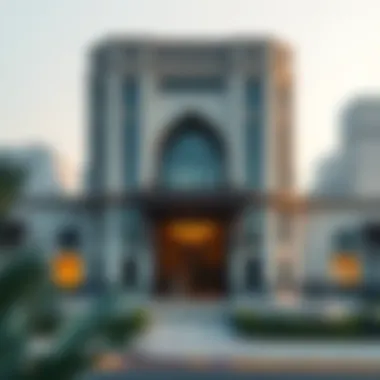

Cultural Significance
The Juma Al Majid Building is steeped in cultural significance, embodying the values and traditions of the local populace. It serves as a landmark that tells the story of Dubai's growth from a modest fishing village to a bustling metropolis. Visitors often remark on the blend of traditional and modern architectural styles, which mirror the historical narrative of the region.
- The intricate designs echo elements of local craftsmanship, reinforcing a sense of pride among residents.
- Community events, exhibitions, and cultural programs frequently held in the building foster a stronger connection among the citizens.
- Partnerships with local artists and craftsmen highlight the importance of preserving heritage while encouraging innovation.
The building stands as a testament to Islamic architecture’s core principles, showcasing delicate calligraphy and geometric patterns that resonate with the region's identity. It serves as a cultural hub where history and contemporary life converge, making it a vital resource for educational and social interactions in the community.
Community Development Initiatives
The impact of the Juma Al Majid Building on community development is far-reaching. Its strategic role goes beyond mere aesthetics or business viability; it actively contributes to local growth.
- Educational Programs: Workshops and seminars hosted within its walls cater to a range of age groups, focusing on education about the city’s history and culture.
- Economic Boost: By attracting both locals and tourists, the building helps stimulate local businesses, from craft shops to cafes.
- Social Cohesion: Events organized here encourage community gatherings, fostering relationships and cultural exchanges among diverse groups.
The building reinforces Al Nahda's place as a vibrant community while facilitating engagement and development.
“Cultural heritage is not just about monuments; it is about the memories, stories, and connections that bring communities together.”
The Juma Al Majid Building serves as more than an architectural marvel. It is a living entity, breathing life into the surrounding area and uniting the past, present, and future of the community.
Future Developments in Al Nahda
The rapidly evolving landscape of Al Nahda reveals a wealth of opportunities tied to the upcoming developments in the area. As Dubai continues to grow and diversify, understanding the future prospects in Al Nahda can offer investors and local businesses vital insights into the market dynamics. These developments are not merely urban plans; they represent strategic enhancements that promise to reshape the community, augment infrastructure, and bolster commercial viability. The importance of future developments in Al Nahda cannot be overstated, as they will instigate a ripple effect, enhancing property values and lifestyle offerings in the vicinity.
Planned Projects
One can't help but get excited about the potential transformations planned for Al Nahda. Several projects are on the horizon that could drastically change the area’s infrastructure and reputation. Some of these include:
- Expansion of Public Parks: Appreciating green spaces is a growing trend, and Al Nahda is no exception. Upcoming projects will bring new parks to the district, promoting a healthier lifestyle and community engagement.
- Residential Complexes: Developers are eyeing Al Nahda for mixed-use residential buildings. These complexes will not only cater to families but also attract young professionals who seek proximity to business hubs.
- Commercial Centers: As foot traffic increases, plans for new shopping malls and commercial centers are underway. These will cater to the needs of both residents and visitors, offering retail, entertainment, and dining options.
- Transportation Improvements: Enhancements in transport infrastructure, including new metro stations and road expansions, aim to improve accessibility, making it easier for people to live and work in Al Nahda.
Each of these planned initiatives highlights a commitment to creating a balanced, vibrant community that meets the needs of its residents while drawing in new investments.
Anticipated Market Trends
The future of Al Nahda's marketplace appears bright and is dictated by several anticipated trends that investors and homeowners should keep an eye on. The following factors could shape the economic landscape of Al Nahda in the coming years:
- Increased Demand for Commercial Space: With ongoing developments, an uptick in businesses seeking storefronts and office spaces is expected. This surge could translate into better rental yields for investors.
- Sustainable Development Focus: As environmental consciousness grows, developments in Al Nahda are likely to incorporate sustainable practices. This shift might attract eco-friendly brands and conscious consumers, enhancing community appeal.
- Gentrification Effects: As the area modernizes, property values may rise. With higher demand for housing and commercial spaces, existing lot owners could see significant returns on their investments.
- Cultural and Social Investments: Community centers and cultural projects are on the horizon, fostering a rich local culture that could attract even more diverse residents.
Finale on Future Developments
In summary, the planned initiatives and anticipated trends in Al Nahda are more than just construction projects; they signify a bold vision for the future. As these developments unfold, they promise to not only enhance the aesthetic of the area but also expand its economic footprint. Investors, homeowners, and stakeholders should remain vigilant, as the community evolves and unlocks new avenues for collaboration and growth.
"The future belongs to those who believe in the beauty of their dreams." — Eleanor Roosevelt.
This encapsulates the spirit of Al Nahda, where dreams of modern urban living are slowly becoming a reality.
Finale
The conclusion of this article encapsulates the intricate layers surrounding the Juma Al Majid Building, a landmark not just in the Al Nahda district, but also in Dubai’s architectural narrative. What emerges from this exploration is the building's dual importance—historically and commercially.
Summary of Insights
Throughout the article, we have woven together the various dimensions of this building. From its architectural grandeur and sustainability features to its implications for the local real estate market, each section has underscored its multifaceted role. The building represents more than just bricks and mortar; it is a testament to how historic elements can harmonize with modern innovation. Notably, its strategic placement makes it a desirable spot for businesses, attracting both local and international investors.
Final Thoughts
In closing, the Juma Al Majid Building is a symbolic bridge between Dubai’s rich cultural past and its dynamic present. As the region continues to evolve, the building stands as a vital player in shaping the community's fabric and economic landscape. Investors and homeowners alike will do well to consider not just the commercial potential, but also the historical and cultural significances infused into this architectural marvel. Understanding these aspects might provide significant advantages when assessing the opportunities it presents.
"The Juma Al Majid Building is not merely a structure; it's a narrative of resilience and future possibilities within an ever-changing urban landscape."
With the insights provided here, stakeholders are better equipped to navigate the complexities of the market while appreciating the aesthetic and cultural values that the Juma Al Majid Building brings to Al Nahda.


